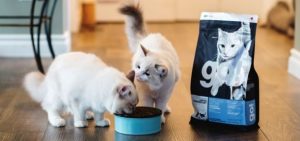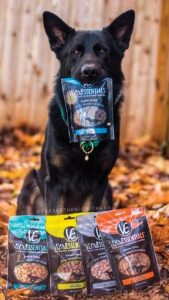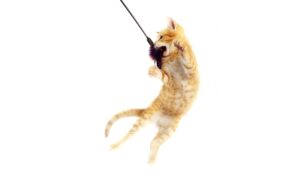Feeding Time: Owners Demand Healthy Ingredients, Condition-Specific Recipes
Alexandra Wepner//February 21, 2018//
Feeding Time: Owners Demand Healthy Ingredients, Condition-Specific Recipes
Alexandra Wepner //February 21, 2018//
In 2016, customers spent $26.5 billion on pet food. According to John Gibbons, the Pet Business Professor, pet food and treats make up the largest swath of pet product sales in the U.S.
“It’s basically an anchor for the store,” said Matt Ruona, co-owner of Four Paws on the Beach, along with his wife, Meghan. “In particular, for the locals in the area, we are the source for premium pet food… We brought in things like ACANA and ORIJEN as well as a full freezer for raw selection and freeze-dried foods—Stella & Chewy’s, their raw coated kibble, that type of stuff… We’re pretty much known in the area as the place to go for premium, higher-end pet food and as an educational resource as well, and people are seeing the results [of feeding premium foods].”
The humanization of pets and premiumization of products go hand in hand. And as humans have learned more about their own health and how their food is made, those concerns have begun to extend to their pets. In fact, Gibbons identifies four major trends over the last two decades that have led us to where we are today.
“Sales seem to have really taken off after 2003. That was the year IAMS went into the mass market and may have signaled the first phase of the premiumization of pet food,” he wrote in a post on pet spending in September 2017. “Then came ‘Made in USA’ because of the melamine recall, which was followed by ‘Natural.’ Then in 2014, we got ‘Super Premium.’ What is next? The indication is ever-increasing ‘Humanization.’”
Ruona offers an explanation.
“I think it goes hand in hand with human nutrition,” he said. “As we’ve been learning more over the last few decades [about] human health, ties to diet, exercise… I think when people then are presented with, ‘Oh, well, this applies to my dog as well; this living thing, what you put in is what you get out.’”
Ruona also makes the point that, if owners aren’t spending the extra cash for premium foods, they’ll likely only transfer that spending to another, less pleasant expense.
“You’re going to be spending that money one way or another generally, whether it’s going into the food that’s keeping them healthy up front or vet bills at the back end,” he said.
Gibbons’ research seems to support this idea. In 2015, spending on pet food increased and many attributed the extra spending to pet owners’ preference changing to favor premium pet foods. A dip in 2016 in this same segment occurred, although Gibbons offers several explanations, including discounts on premium foods and increasing market competition. At the same time, “they gave most of it back by spending an additional $2.53 billion on supplies, services and veterinary,” he wrote in December.
What Do They Want?
“Consumers are looking for new ingredients to try that are good for the planet and nutritionally beneficial, which aligns with our mission and heritage, and provides additional interest and demand for us to continue developing new recipes and sustainable sourcing and manufacturing practices,” said Annabelle Immega, trade marketing manager for Petcurean.
Petcurean’s answer to this growing demand is its organic and sustainably sourced recipe, GATHER. Immega mentions millennials as one of the groups most interested in premium, quality ingredients and how they’ve arrived in their pets’ food. 
Brad Gruber, president and COO of Health Extension Pet Care, agrees. The company offers a comprehensive list of its ingredients—including fresh meats, coconut oil, ginger and green tea, chicory, turmeric, organic apple cider vinegar, colostrum, whole vegetables and berries, probiotics, prebiotics and kelp—and their benefits on its website. Grain-free dry and canned dog and cat food are available, as well as 95 percent meat mixes to entice pets at mealtime and increase their protein intake.
“According to Petfood Industry, 95 percent of pet owners consider pets to be part of their family,” Gruber said. “And fortunately for pet food manufacturers, today’s millennials are willing to spend more money than ever before to feed their pets.”
For instance, Grizzly Pet Products offers a Super Foods line for dogs and cats, with Wild Alaskan salmon as the first ingredient; several organic ingredients such as coconut meal and quinoa; and no grains, gluten, potatoes, peas or legumes. Merrick offers a specifically Limited Ingredient Diet, made primarily with single source deboned protein and no grains, gluten, wheat, corn, soy, dairy, and eggs or artificial colors, flavors or preservatives. The company’s Classic and Grain-Free lines are made in the USA. Lastly, there’s the newest of the bunch: Elevate Pet Food, billed as a natural, grain-free diet that uses only natural flavors and preservatives for a “cleaner, healthier product.” The dry and wet recipes go one step further to exclude potatoes and use less common ingredients like betaine and fava beans.
“We’ve seen a huge increase in demand for products featuring certifications and premium ingredients such as novel proteins and superfoods,” Immega said. “As a result, we developed a new line of pet food, called GATHER, which is crafted from certified non-GMO and sustainably produced ingredients such as MSC-certified Alaskan cod, certified organic free-run chicken, and includes a certified vegan recipe.”
To bolster the eco-friendliness of the line, the company packages GATHER in USDA-certified bio-based packaging, and Petcurean’s newest NOW FRESH recipes are available in industry-leading 100 percent recyclable, BPA-free Tetra Pak cartons.
Feeding for Function
Part of the premiumization of pet foods is the development of functional and life stage-specific diets. Not only do consumers want fresh, quality ingredients—they also want foods specifically tailored to their pets’ growing and changing bodies.
“As pets grow and age, they require different nutrients,” Immega said. “For example, puppies require high levels of vitamins and minerals to ensure proper growth, while senior dogs, who are often less active, can benefit from a lower calorie food with balanced proteins and fats to help manage weight.”
According to the American Pet Products Association’s 2017-2018 National Pet Owners’ Survey, the average age of a dog in the U.S. in 2016 was 6.7 human years (the average age for cats was 6.9 human years). Many canines begin to experience body and brain changes associated with aging at 7 years old. On the other hand, obesity is one of the most pressing problems facing today’s pets, with more than half of dogs and cats in the U.S. being overweight.
Purina is one company that offers products for both aging and overweight pets, specifically. The Pro Plan Simply Fit system is designed to reduce caloric intake while keeping pets satisfied and their metabolisms active by keeping portion sizes consistent. The company’s Pro Plan Bright Mind formula for dogs 7 and older aims to provide the brain with an additional energy source—namely, botanical oils—to restore memory and learning.
Fromm is another premium brand that organizes its pet food into life stages.
“We offer life stage specific foods like Puppy Gold, Large Breed Puppy Gold and Reduced Activity Senior Gold to better serve the unique nutritional needs for specific life stages,” said Bryan Nieman, brand director for Fromm Family Foods. “While we offer ‘all life stages’ recipes in our Four-Star Nutritionals product line, the ability to craft a ‘life stage’ specific recipe for a specific purpose during an important life stage allows us to optimally meet the nutritional needs in the most efficient way possible.”
The reason for all this innovation really boils down to changing demands from consumers. Several of Fromm’s products are grain-free, and each of the recipes in the Gold line utilize different types of proteins.
“The changing demands of consumers has provided us with ample opportunities for creative line extensions of our core product lines,” Neiman said. “Whether it’s been meeting consumer demands for trends like grain-free foods, or simply offering more interchangeable recipes to offer variety, we’re excited to continue applying our time-tested scientific approach to formulating new recipes that meet the preferences of today’s pet parents.”
Gruber agrees that customers are expecting different things from pet food companies. 
“As the way people treat their pets evolves, the humanization of pet foods is affecting pet food trends and what a customer is willing to feed their pet, even given the high cost of some brands reaching the over-$100 mark for a bag of food,” he said. “Given the fact that there isn’t much today’s consumer won’t do for their pet, they desire higher quality pet foods that address the same health concerns influencing human food and their own diets.
“Years of feeding commercial diets out of convenience, breeding practices and the development of designer breeds have created different dietary needs for pets,” he continued. “In addition, the increase in environmental changes has raised the awareness of allergies and all causes for health concerns with dogs. Oftentimes, by feeding a grain-free diet, many of these issues can be resolved or at least controlled. Not all dogs can process or digest grain properly and flourish on a higher meat based protein recipe. By offering a grain-free formula, we provide a healthy alternative for pets requiring diets linked closer to their ancestral needs.”
Simple, Strong, Raw
“Stuff that we look for is U.S.-made [and] as local as we can get, so we’ve supported brands like Primal and Northwest Natural out of Portland,” Ruona said. “But also, things that mean a lot to us are things that are as limited ingredient as possible. That’s why brands such as Zignature have been attractive… Just quality ingredients, high protein count. We’re also big advocates of the raw movement as well, just because we’ve seen the results.”
He recalls a customer that came into the shop earlier in 2017 with a cat that had recently been diagnosed as diabetic. After some research, he learned that a diet rich in meat and excluding grains and carbohydrates might help the animal. Luckily, the store carries a variety of full or partially raw diets as well as those with high protein content, including Fussie Cat, Weruva, Pure Vita and Taste of the Wild.
“As soon as we got the cat onto… foods that were pretty much just straight meat in the can, no carbohydrates or fruits and vegetables, it turned the cat right around almost immediately,” he said. “Being able to see those kinds of results was pretty much just proof in practice.”
“The RAW pet food category grew by 32 percent in 2016 and, from what we’re seeing with our Vital Essentials products, is on pace for even bigger growth this year,” said Kevin Malnor, VP of sales and marketing for Vital Essentials Raw. “And this growth is being led by freeze-dried foods and treats. As a retailer, if you haven’t added ultra-premium raw options to your store, you’re missing out on a huge opportunity to get ahead of larger big box retailers that are not supplying these health-conscious options to pet parents.” 
One of the most common concerns retailers have with entering the raw pet food market is space and storage. Malnor insists that Vital Essentials products are easier to add to stores than one might think: their freeze dried treats for cats and dogs come in convenient packaging that can be displayed on shelves or hung on a peg rack; the entree packages for dogs are only one pound, and the mini patty entrees for cats come in eye-catching, display-ready cases; and the raw freezedried mini-nibs come in 12-ounce bags.
For those retailers who would like to test the waters of raw pet food, Malnor recommends the VE RAW BAR.
“Our award-winning VE RAW BAR merchandise display consists of 12 raw freeze-dried snacks ranging from the commonplace like Pig Ears and Bully Sticks to the exotic like Duck Heads and Pig Snouts,” he said. “Th e VE RAW BAR is highly flexible when it comes to its footprint as well; it can be displayed on an end-cap, window or cash register display area or tabletop/countertop display. We’ve received hundreds of photos from retailers who have gotten creative in their space use, optimizing otherwise underutilized areas in their store to generate high turn, high margin revenue.
“An added bonus of having a highly visible raw freeze-dried snack display such as our VE RAW BAR is the ability to open up conversations with pet parents about the benefits of raw feeding,” Malnor said.
“And that’s why we like to have a fairly wide range of products, so customers have an entry way into that whole world [of raw],” Ruona said. “We’ve found [that] the Stella & Chewy’s, the kibble topper line, that was pretty much the first thing that we had in the shop when it comes to raw. [It] allows customers to add it to whatever they’re feeding their dog currently… Th at just allows the customer to, in a cost eff ective way, introduce raw into their routine.”
According to Malnor, many customers transitioning to raw pet food might be more comfortable with freeze-dried products, which can be safely and conveniently stored without refrigeration. That’s also a bonus for stores that don’t yet have freezers. These products, Malnor says, can be fed as a complete meal or used as a topper or training reward.
Not Just Kibble
It’s easy to fixate on cat and dog brands when talking about pet food, but they’re obviously not the only animals that need high-quality diets to thrive. And that’s something that reptile, bird, small animal and fish owners as well as retailers know very well.
“We are seeing a real change in the patterns of small pet ownership,” said Claire Hamblion, marketing manager at Supreme Petfoods. “Many millennials and other adults are being drawn to small pets such as rabbits and guinea pigs which fit in with smaller homes and busy lifestyles but still off er all the benefits of loving companionship. These owners are often very educated about their pets’ nutritional needs and prepared to pay more for quality.
“In fact, we carried out a survey of almost 700 owners of small pets last year and found that 30 percent thought that rabbit foods were too cheap and would prefer to pay more for higher quality,” Hamblion added. “As with dog and cat foods, this has meant there is a strong demand for natural products. Owners of small pets felt that this meant the inclusion of hay and grass, wild plants and herbs and plain, simple ingredients without unnecessary additions.”
Just one highlight of Supreme’s product offerings is the Selective GrainFree line, available in formulas for rabbits and guinea pigs. It’s rich in high fiber Timothy hay and is made with garden vegetables and no corn or wheat, according to the company’s website.
“We believe that grain-free is about offering choice and responding to what pet owners want,” Hamblion said. “Our survey of almost 700 small pet owners found that 50 percent of respondents felt that grain-free would be less likely to cause health problems in their pets and 35 percent felt the food would be easier to digest, while others felt it would provide a welcome choice. When those pet owners were asked how they selected products based on the cereals they contained, corn and wheat performed particularly badly, while more than 70 percent said they would actively seek out grain-free. The feedback about our grain-free range has been very positive, so it’s great to see that it has met customers’ expectations.”
Also in the small animal segment, ZuPreem offers a grain-free ferret diet along with its Nature’s Promise Timothy Naturals line, which is made in the USA, and “tested and monitored for pesticides,” according to the ZuPreem website. The company also produces a variety of diets for birds with different functions: the Smart Selects line is designed to have “smart levels of fat and sodium” and excludes sunflower seeds, and the Essential Nutrition Natural recipe has added vitamins, minerals and amino acids, to name just two. Another premium option for small animal pet owners is Oxbow’s BeneTerra Organics line, which is created with certified organic ingredients and is designed to imitate the diet that animals would follow in the wild.
“San Francisco Bay Brand and Ocean Nutrition have always been considered premium brands due to the use of whole, natural, human grade ingredients, and both companies are more than 35 years old,” said Jason Oneppo, the companies’ R&D manager. “Where we notice the difference is in sales; the sales of premium frozen and freeze dried foods continues to grow, so it is safe to say that the fish and reptile markets are riding the coattails of the dog and cat food market as many dog and cat owners have fish or reptiles and want to offer all their pets a high quality lifestyle and diet.”
San Francisco Bay Brand and Ocean Nutrition offer a range of products for fish and reptiles. Their freeze-dried single ingredient foods for fish do not need freezer storage and “can be used to soak up vitamins, supplements and medications so they are delivered directly into the fish and they are easy to use,” according to Oneppo. They’re especially beneficial because they come very close to what these animals would eat in the wild, so they’re very enticing. They can be used as a treat or as a staple food.
“Frozen formula foods are basically a blend of a variety of single-ingredient foods, with some additional ingredients such as aquatic plants and vitamins and other premium ingredients that would be cost prohibitive as a single item,” he said.
Oneppo adds that, while the use of frozen foods has been common with marine hobbyists for quite some time, only advanced freshwater aquarists tended to feed with these diets. Now, customers are more knowledgeable and stores more commonly stock frozen foods.
For reptiles, single item freeze-dried foods are available. San Francisco Bay Brand’s cactus product, in particular, is unique because freeze-drying the food extends its shelf life by several years without losing nutritional value, whereas it is usually available only seasonally. San Francisco Bay Brand’s instant meals “take the guesswork and hassle out of making a nutritious meal” for a reptilian pet, according to the company’s website. These diets, which also include ingredients that are usually only seasonal, are formulated to off er “the proper ratio of calcium, phosphorus and vitamins,” along with other beneficial foods, Oneppo said.
Another important part of the reptile food market is live feed, which helps to drive customers into brick and mortar stores every few days. Armstrong’s Cricket Farm and Fluker’s Cricket Farm off er a variety of feeder insects in addition to crickets. Timberline, which produces an array of feeder insects in a variety of sizes, is well known for its Vita-Bugs, which carry enhanced Vitamin E, BetaCarotene, and Omega-6 and Omega-3 fatty acids.
“In nature, fish and reptiles feed on a variety of foods,” Oneppo said. “Sometimes they feed on what they happen to come across when they are hungry and other times their diet is determined by seasonal changes and the foods that are available during those times. Offering your pets a variety of food will keep them from becoming bored eating just one item and will also provide organic and inorganic nutrients w h i c h meet their unique dietary needs.”



















